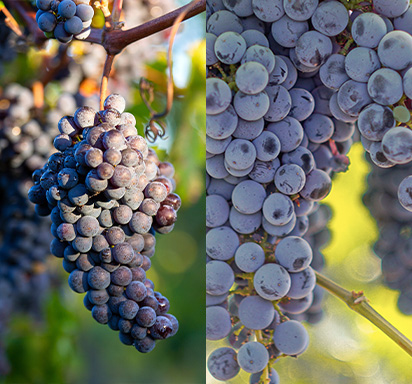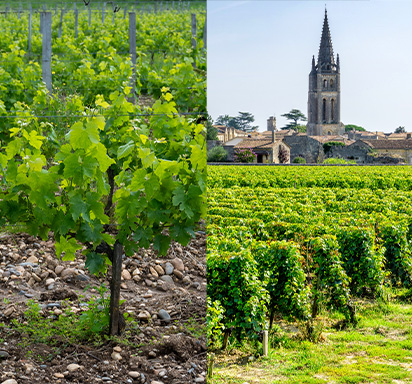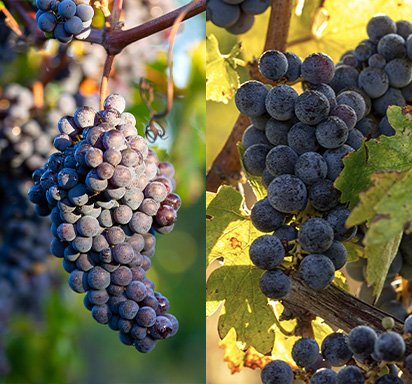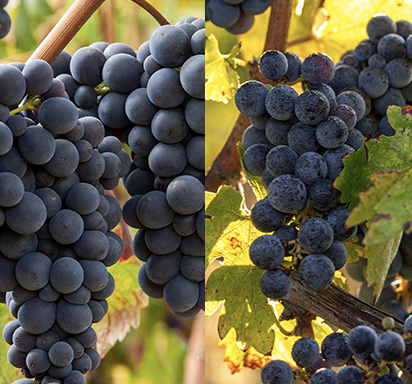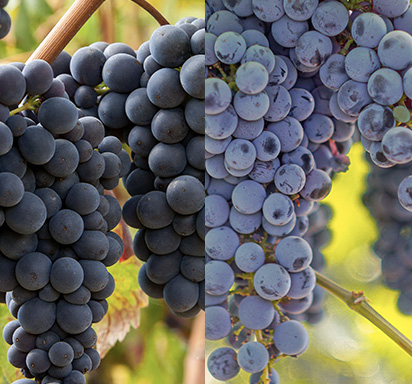Cabernet Sauvignon vs. Cabernet Franc: Two Iconic Red Grapes
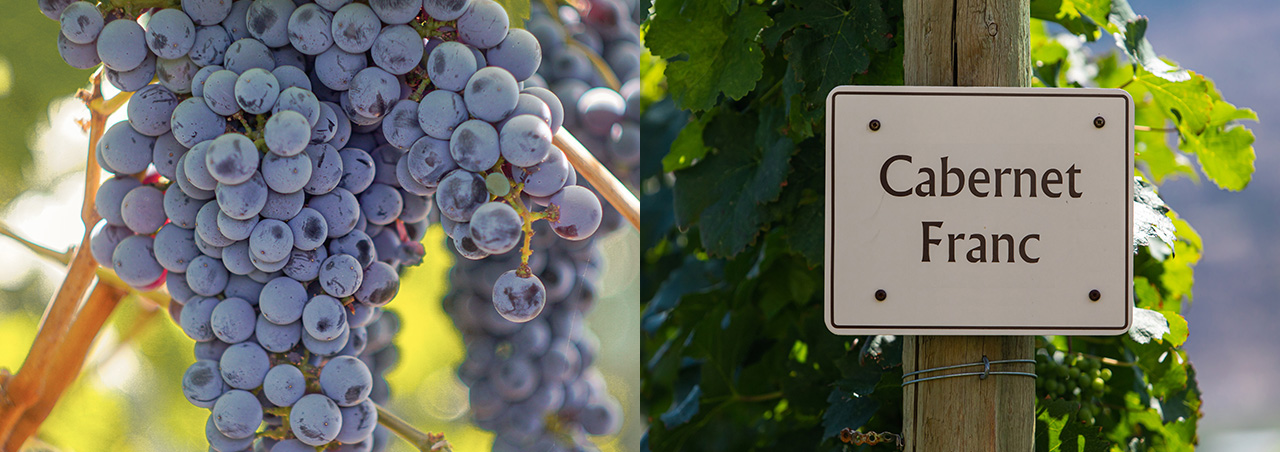
Explore the key differences between Cabernet Sauvignon and Cabernet Franc—from origins and flavor profiles to winemaking roles—so you can better choose and enjoy these iconic red grapes.
When wine enthusiasts talk about Bordeaux blends or bold red wines, two names inevitably come up: Cabernet Sauvignon and Cabernet Franc. While these grapes share a family connection and some similarities, they are distinct in flavor, history, and role in winemaking. Whether you’re curious about their origins, tasting profiles, or how they complement each other in blends, this guide will give you a clear picture of these two celebrated varietals.
Origins and Relationship
Cabernet Franc is actually the older of the two grapes and is believed to have been growing in France since the 17th century. It is thought to be one of the parent grapes of Cabernet Sauvignon — a natural cross between Cabernet Franc and Sauvignon Blanc that likely occurred in the Bordeaux region sometime in the 17th or 18th century.
While Cabernet Franc has historically been more prominent in Loire Valley and certain Bordeaux appellations, Cabernet Sauvignon rose to global fame as the dominant grape of Bordeaux’s Left Bank and as a flagship varietal in regions like Napa Valley.
Cabernet Sauvignon & Cabernet Franc: Where Do They Grow?
Both grapes originated in France but now grow widely across the world:
Cabernet Sauvignon thrives in warmer climates such as Bordeaux’s Left Bank, Napa Valley, Australia’s Coonawarra, Chile’s Maipo Valley, and parts of Italy and South Africa.
Cabernet Franc prefers slightly cooler climates and is a major component of wines from the Loire Valley (notably Chinon and Bourgueil) as well as Bordeaux blends. It also grows in the northeastern United States (New York and Virginia), Canada, and parts of California.
Flavor Profiles and Characteristics
Cabernet Sauvignon
Cabernet Sauvignon is known for its full body, firm tannins, and high acidity, making it a classic candidate for aging. It offers intense black fruit flavors such as blackcurrant (cassis), blackberry, and black cherry. Oak aging often contributes notes of cedar, vanilla, and sometimes tobacco or graphite. Its bold structure gives it excellent aging potential, often improving over 10-20 years or more.
Cabernet Franc
Cabernet Franc is lighter-bodied, with softer tannins and higher aromatics. It typically shows red fruit flavors like raspberry, red cherry, and plum, accompanied by distinctive herbal, floral, and sometimes green pepper notes. Compared to Cabernet Sauvignon, it’s more delicate and approachable in youth but also offers complexity and freshness.
How They’re Used in Winemaking
Blending
Cabernet Franc is a classic blending partner with Cabernet Sauvignon and Merlot in Bordeaux-style wines. It adds aromatic lift, finesse, and complexity to blends that might otherwise be dense or heavy.
Single Varietal Wines
While Cabernet Sauvignon is widely bottled on its own, Cabernet Franc also shines as a single varietal, especially in the Loire Valley (e.g., Chinon) and in New World regions where winemakers want a fresher, lighter style.
Similarities and Differences between Cabernet Sauvignon & Cabernet Franc
Similarities:
Both are red Bordeaux varietals with good acidity and tannins.
Both contribute to Bordeaux blends, often complementing Merlot and each other.
Both can produce wines capable of aging gracefully.
Both thrive in regions with good drainage and moderate climates.
Differences:
Cabernet Sauvignon is typically fuller-bodied and more tannic, while Cabernet Franc is lighter and more aromatic.
Cabernet Franc often has a herbal, green pepper character, whereas Cabernet Sauvignon leans towards black fruits and oak-driven notes.
Cabernet Sauvignon tends to be more robust and structured, making it a backbone grape, while Cabernet Franc provides elegance and finesse.
Notable Producers
Cabernet Sauvignon:
Château Lafite Rothschild, Château Margaux and Château Latour: Iconic Bordeaux First Growths producing age-worthy Cabernet-dominant wines.
Silver Oak Cellars, and Caymus: Benchmark Napa Cabernets, bold and oak-influenced.
Opus One: Prestigious collaboration in Napa Valley between Mondavi and Rothschild.
Penfolds Bin 707: One of Australia’s flagship Cabernet Sauvignon wines.
Cabernet Franc:
Château Cheval Blanc: Legendary Right Bank Saint-Emilion estate with a Cabernet Franc-led blend.
Château Angelus: A Saint-Emilion Premier Grand Cru Classe that uses a significant proportion of Cabernet Franc for elegance and aromatic lift.
Clos Rougeard: Cult Loire producer in the Saumur-Champigny appellation known for complex, age-worthy Cabernet Franc.
Cabernet Sauvignon or Cabernet Franc: Which Should You Choose?
If you’re seeking a full-bodied, tannic, age-worthy wine with bold dark fruit and oak complexity, Cabernet Sauvignon is your best bet. It’s perfect for special occasions, cellar aging, and pairing with rich dishes like steak or lamb.
If you prefer something a bit lighter, more aromatic, and approachable earlier, Cabernet Franc offers bright red fruit flavors with herbal and floral nuances. It’s great with roasted poultry, grilled vegetables, or charcuterie.
Conclusion: Two Grapes, One Bordeaux Legacy
Cabernet Sauvignon and Cabernet Franc share a fascinating genetic link and complementary roles in winemaking. Understanding their differences and how they work together enriches your appreciation of Bordeaux blends and varietal wines alike.
Whether you savor the bold power of Cabernet Sauvignon or the fragrant finesse of Cabernet Franc, both grapes invite you on a journey through history, terroir, and taste.
You may like
Explore the key differences between Malbec and Cabernet Sauvignon — from origins and taste profiles to food pairings and top producers — to discover which red wine suits your style best.
6/16/2025The exceptional concentration of top-tier wineries and renowned appellations has long made Bordeaux a place of longing for fine wine enthusiasts and discerning hedonists around the world.
4/18/2025Malbec and Merlot are two beloved red wines, each with unique flavors, tannins,& origins. Malbec offers bold, dark fruit flavors with spice, while Merlot is smoother & more approachable. Learn their differences and food pairings.
4/1/2025Chardonnay and Pinot Grigio are two beloved white wines with distinct flavors. Explore their origins, flavor profiles, body, food pairings, and more to find out which wine suits your taste and occasion best.
3/27/2025Pinot Noir and Merlot are two beloved red wines with distinct flavors, aging potential, and food pairings. Discover their key differences to help you choose the perfect bottle for any occasion.
3/5/2025Pinot Noir vs. Cabernet Sauvignon—two iconic red wines with distinct flavors, body, and food pairings. Learn about their origins, characteristics, and how to choose the perfect bottle for any occasion in this in-depth guide.
3/4/2025






















